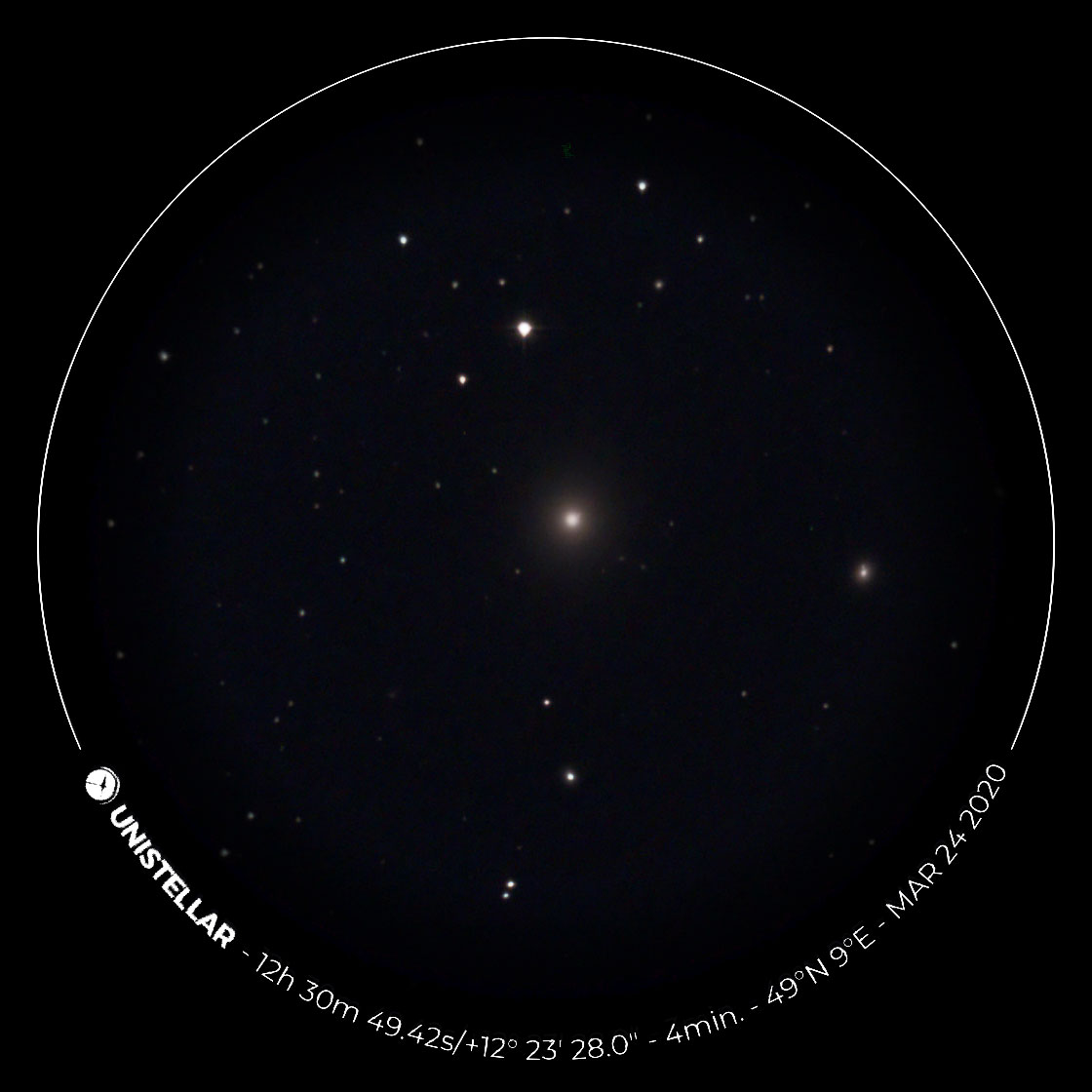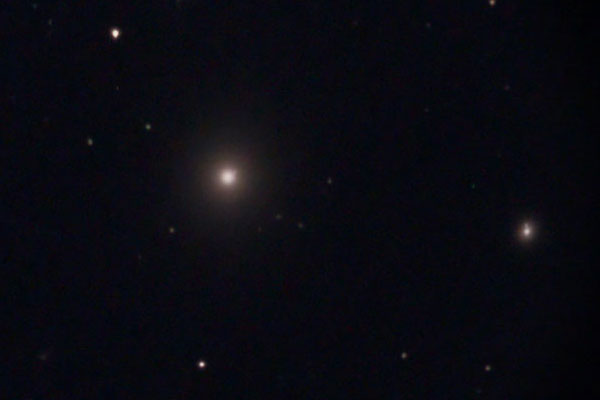

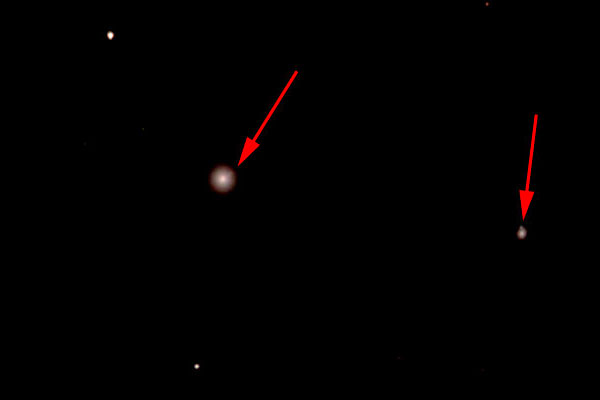
M 87 - Mar 24, 2020 (overlay of two photos). The jet is hard to see.
M 87 - Mar 24, 2020 (overlay of two photos). The left arrow points to the jet, the right to NGC 4478
Introduction | Map | Sketch | My Own Photos | My Own Observations | References || Appendix: The Jet
On this page I collect my observations of the elliptical galaxy M 87 (NGC 4486) in the constellation Virgo. The smaller elliptical galaxy NGC 4478 is in the same field of view in the eVscope - and the even smaller elliptical galaxy NGC 4476, provided you use the rectangular image format or put M 87 at the edge of the field of view.
According to Karkoschka, the elliptical galaxy M 87 in the constellation Virgo is the central galaxy of the Virgo A cluster and has a brighter core, which I, however, was not able to see visually. In the eVscope it is clearly visible. The smaller elliptical galaxy NGC 4478 is in the same field of view of the eVscope.
The four Messier galaxies M 58, M 87, M 89, and M 90 form a triangle in my Vespera mosaic (see below) with a bright dot at the center. M 87 is the lower right edge of the triangle (in my Vespera mosaic).
It was not until early 2021 that I was informed by a star friend that there is a huge black hole at the center of M 87, whose activity makes M 87 one of the brightest radio and X-ray sources in the sky. A jet emanates from the galaxy's core, accelerating matter to nearly the speed of light. It can be observed visually only with large telescopes . It is, however, possible to photograph the jet - and I even managed to do so with the eVscope, as the following photos demonstrate:
Larger versions of the photos can be found in the appendix.
| M 87 (NGC 4486) | NGC 4478 | NGC 4476 | ||
| Size: 8.3'× 6.6' (Wikipedia) Distance: 55 million light years (Wikipedia) Rating: ** (Stoyan) |
Size: 1.8' x 1.4' (SkySafari) Distance: 55 million light years (SkySafari) Rating: --- |
Size: 1.7' x 1.1' (SkySafari) Distance: 57 million light years (SkySafari) Rating: --- |
The Virgo Galaxy Cluster is a galaxy cluster with at least 1300, but probably more than 2000 galaxies. It lies in the direction of the constellation Virgo; its center is about 54 million light years away from the Milky Way.
The cluster also forms the center of the local supercluster, which is therefore also called the Virgo Supercluster. The Local Group - the galaxy cluster to which the Milky Way and the Andromeda Nebula belong - is, like the Virgo galaxy cluster, part of this supercluster, but forms more of an offshoot of it.
M 87 in constellation Virgo in the Virgo galaxy cluster (close to the center) (Image Courtesy of SkySafari Astronomy, www.simulationcurriculum.com)
The elliptical galaxy M 87 in the constellation Virgo (in the Virgo galaxy cluster) plus the galaxy M 49 (further down) (Image Courtesy of SkySafari Astronomy, www.simulationcurriculum.com)
The elliptical galaxy M 87 in the constellation Virgo (in the Virgo galaxy cluster) and the nearby elliptical galaxy NGC 4478 are located South of Markarian's Chain (Image Courtesy of SkySafari Astronomy, www.simulationcurriculum.com)
The four Messier galaxies M 58, M 87, M 89, and M 90 form a triangle in the Vespera mosaic with a bright dot in the center. At the bottom in the center, there are the Siamese Twins NGC 4567/68. (Image Courtesy of SkySafari Astronomy, www.simulationcurriculum.com)
The sketch by Michael Vlasov (DeepSkyWatch.com) provides a rough impression of what I observed (my impression was much fainter than the sketch): Markarian's Chain, M87 in Virgo Cluster (Messier 87) by Michael Vlasov (Copyright © Michael Vlasov 2016)
Note: I only have the author's permission to link to the sketch.
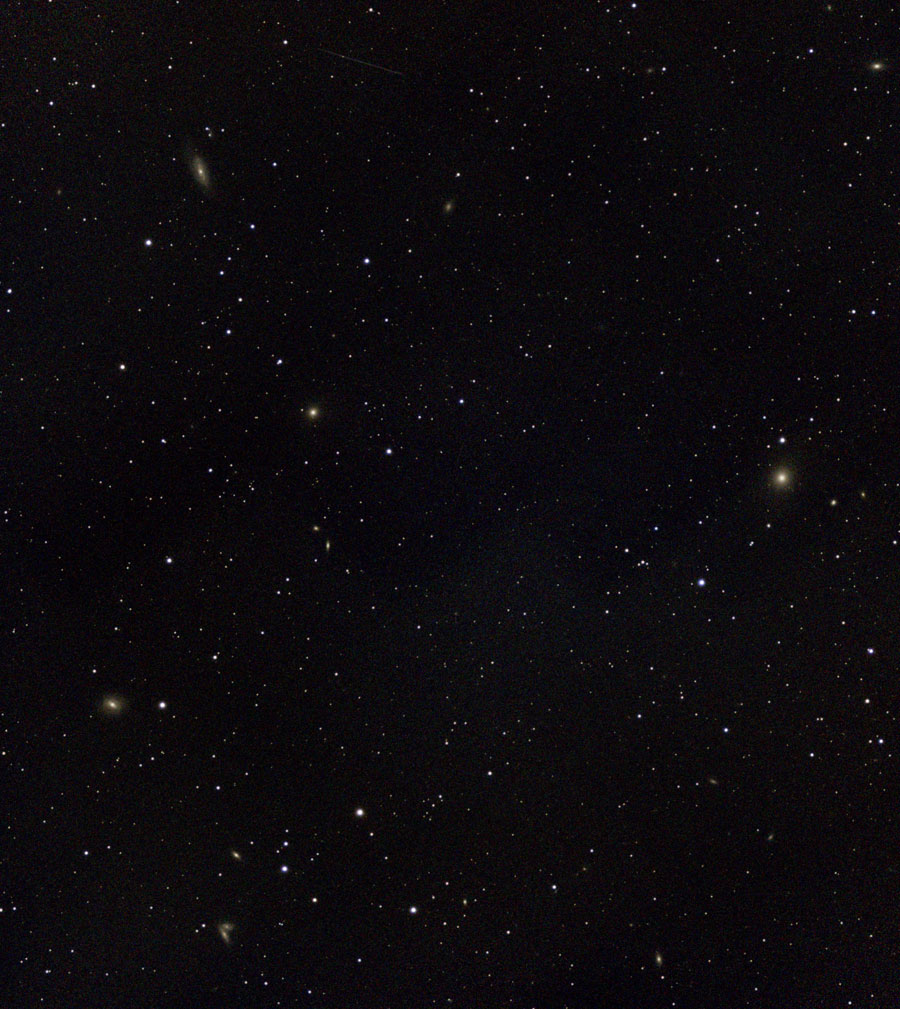 |
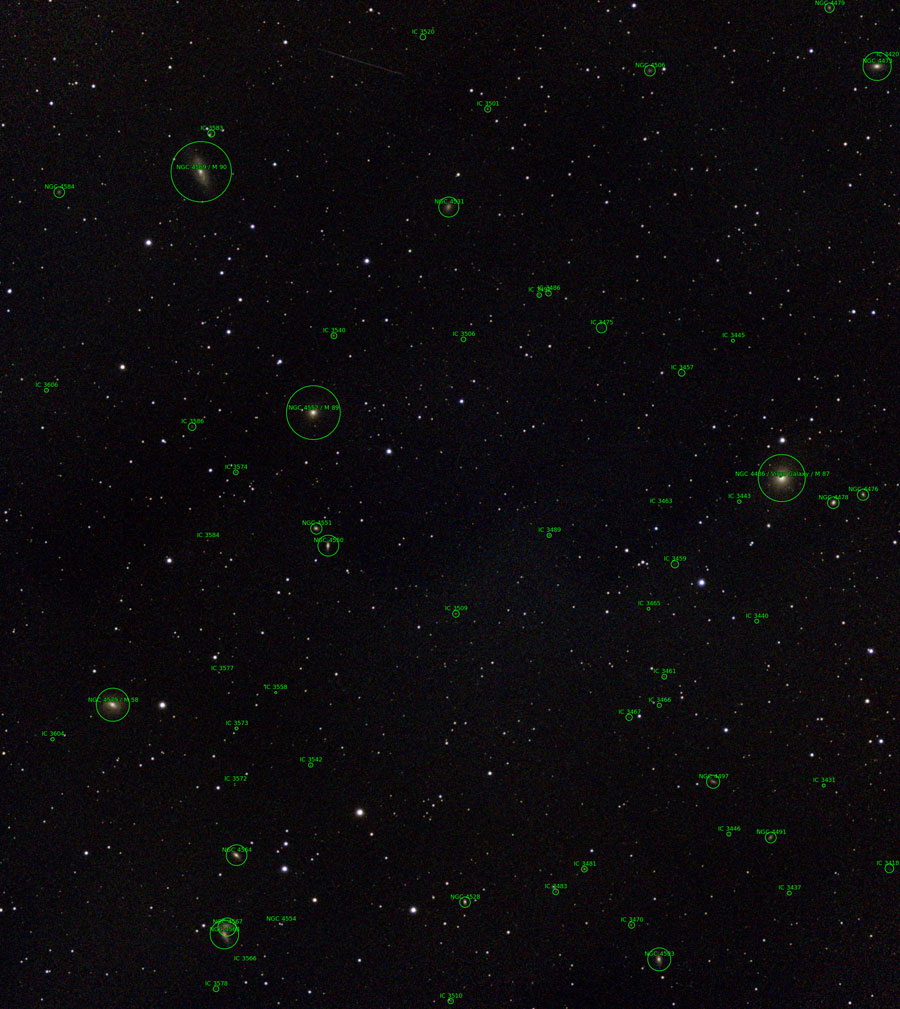 |
|
M 87 - Jun 9, 2023, 6970s, mosaic, original |
Evaluation with nova.astrometry.net, large |
The four Messier galaxies M 58, M 87, M 89, and M 90 form a triangle in the Vespera mosaic with a bright dot in the center. M 87 is the lower right edge of the triangle. At the bottom left, there are the Siamese Twins NGC 4567/68.
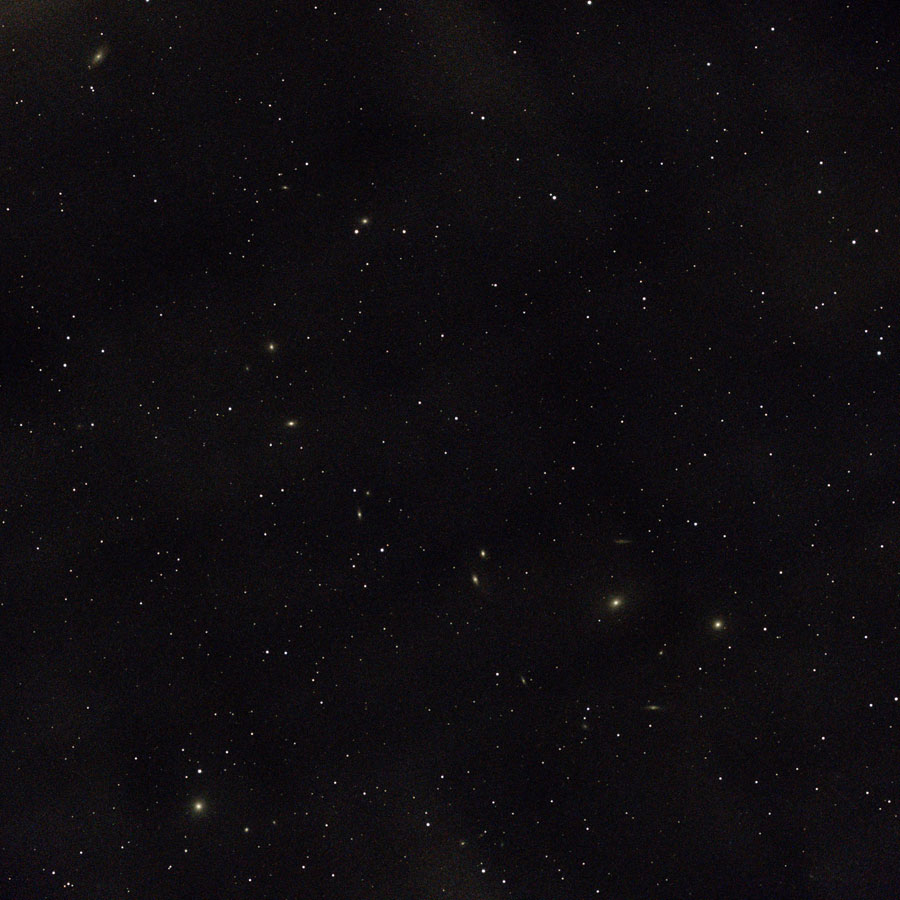 |
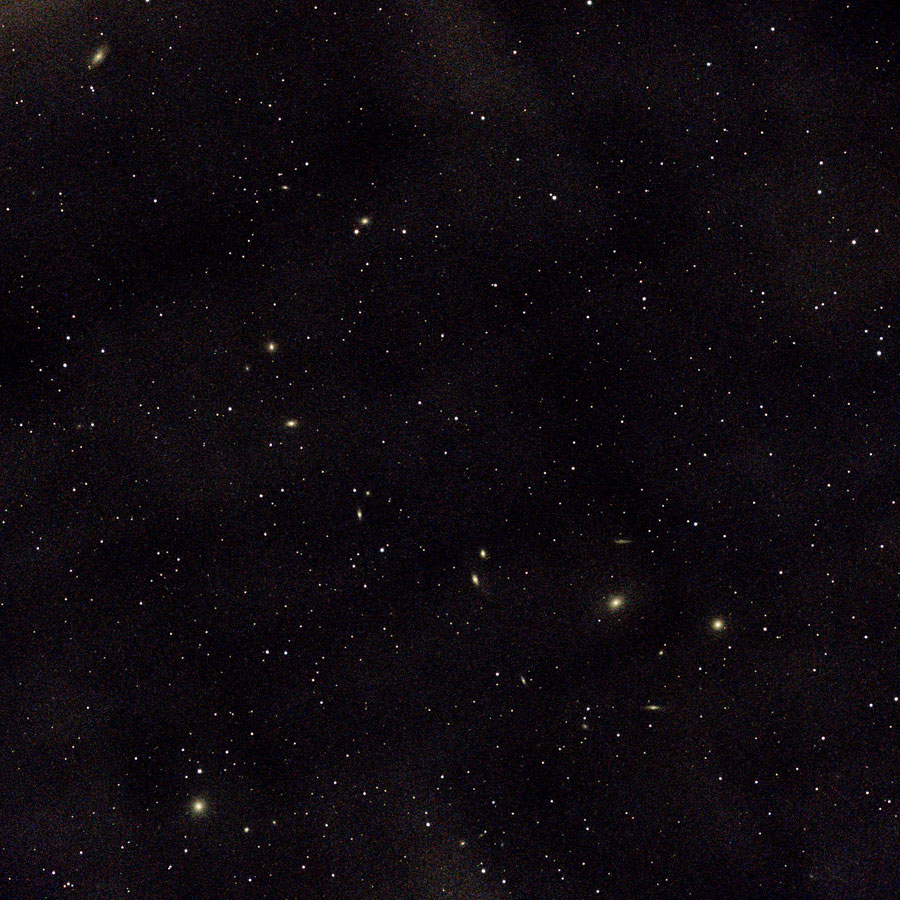 |
|
Markarian's Chain and more - May 14, 2024, mosaic, 2580s, 2000p |
Ditto, processed, 2000p |
|
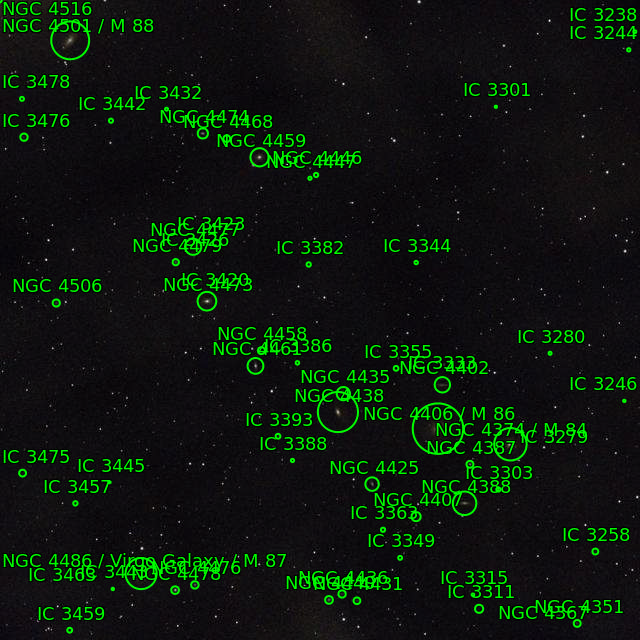 |
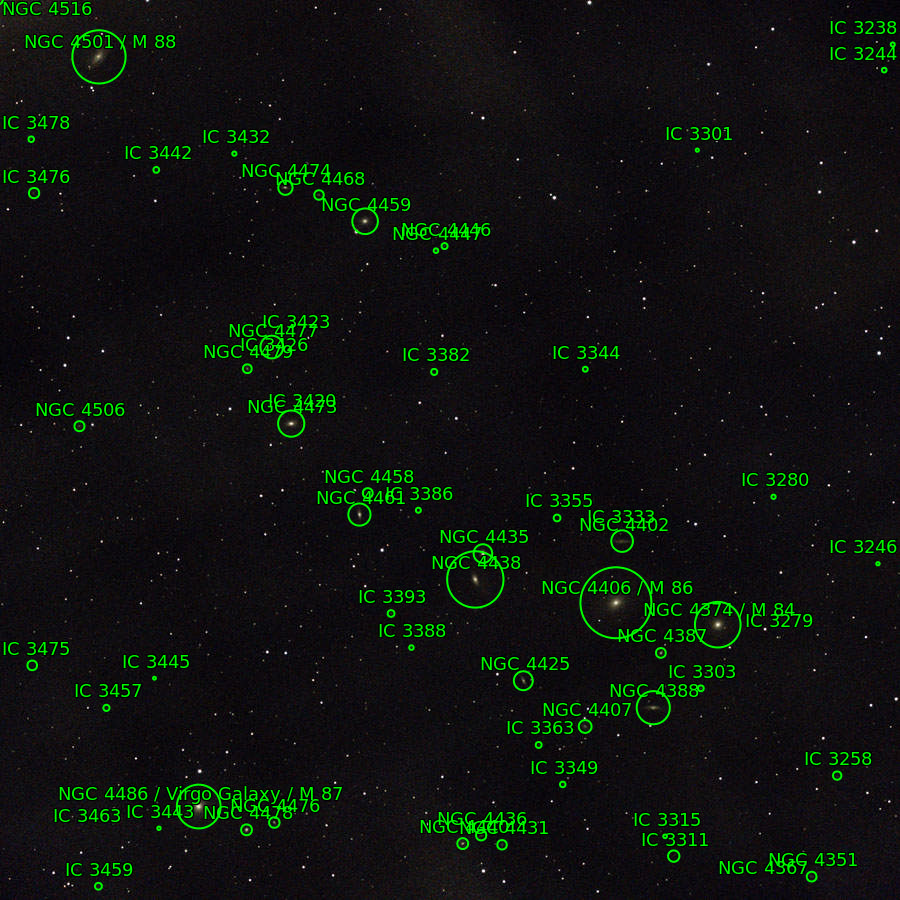 |
|
Evaluation with nova.astrometry.net |
Evaluation with nova.astrometry.net |
|
Too many galaxies for listing them here! M 87 at the bottom left, M 88 at the top left. |
||
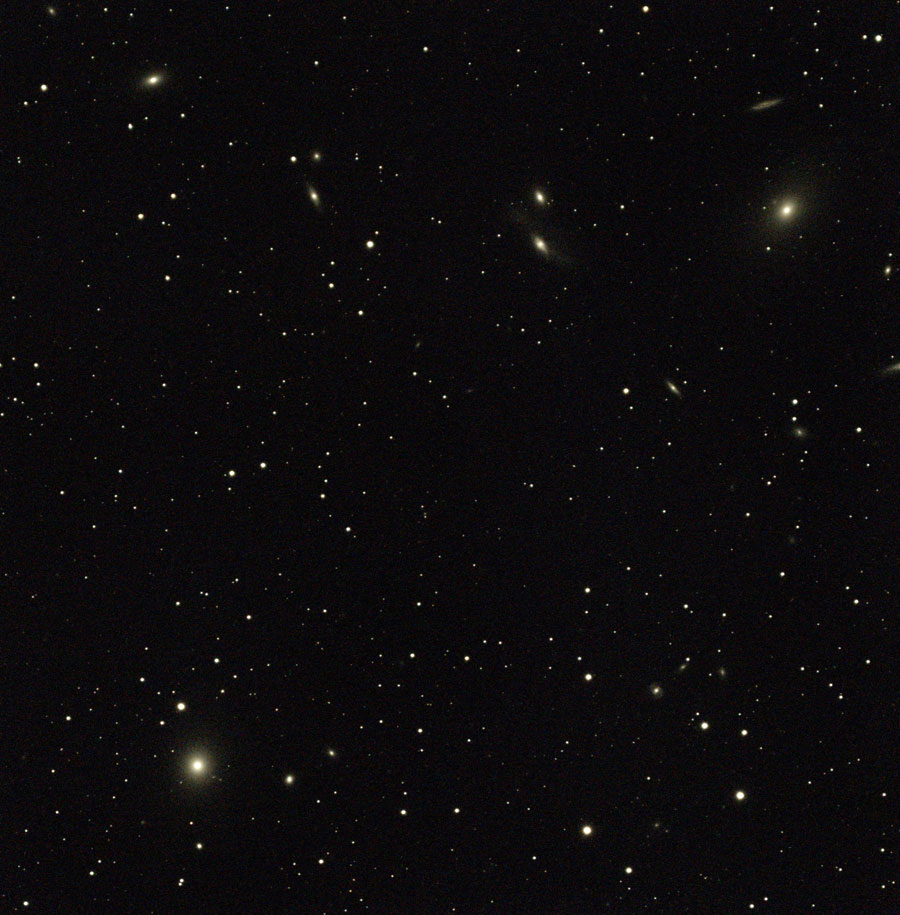 |
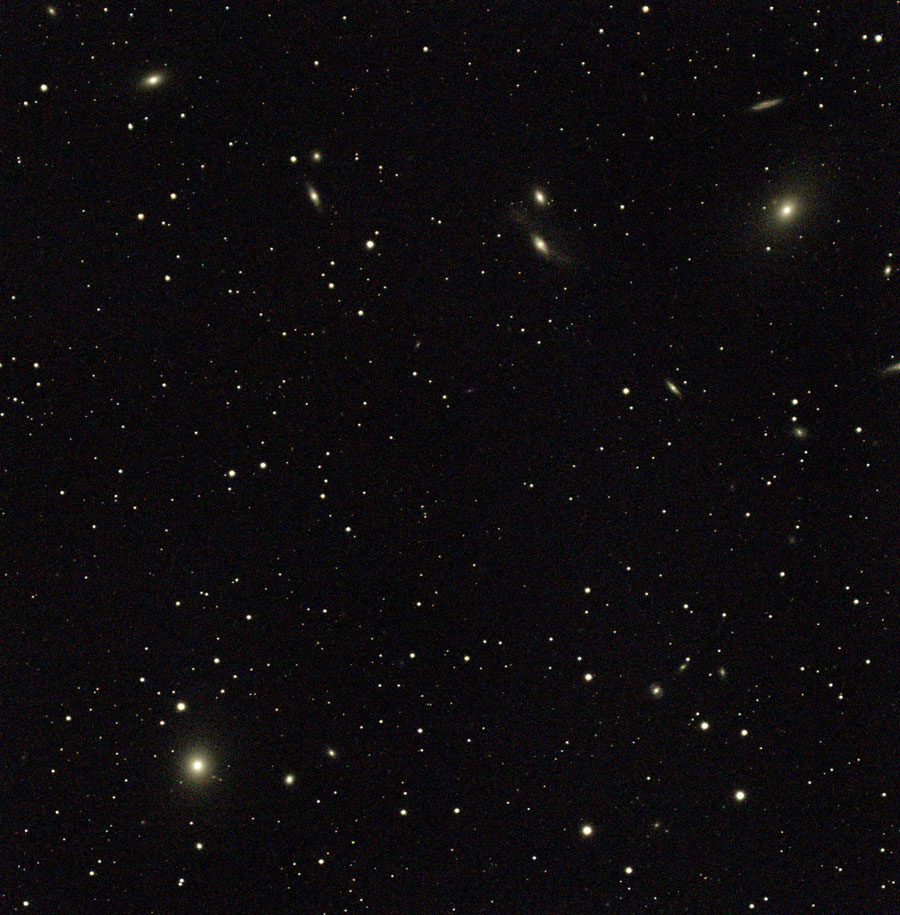 |
|
M 87, Apr 20, 2025 - 2000p, 17 min |
M 87, Apr 20, 2025 - 2000p, 17 min, processed |
|
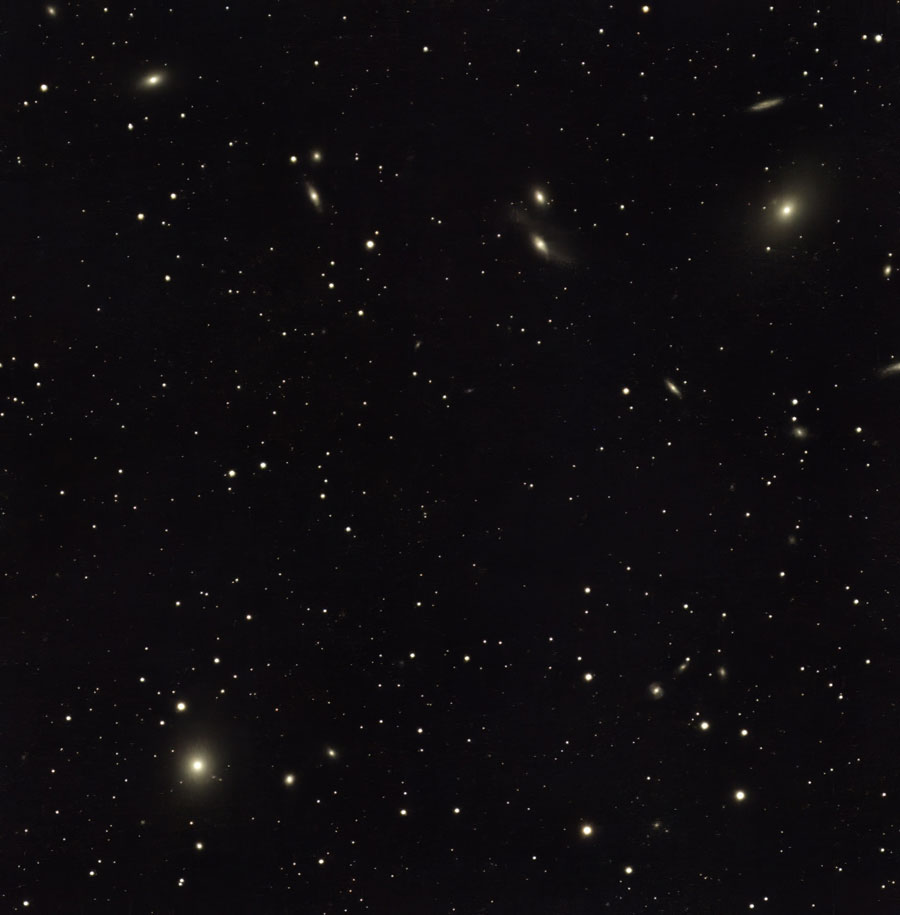 |
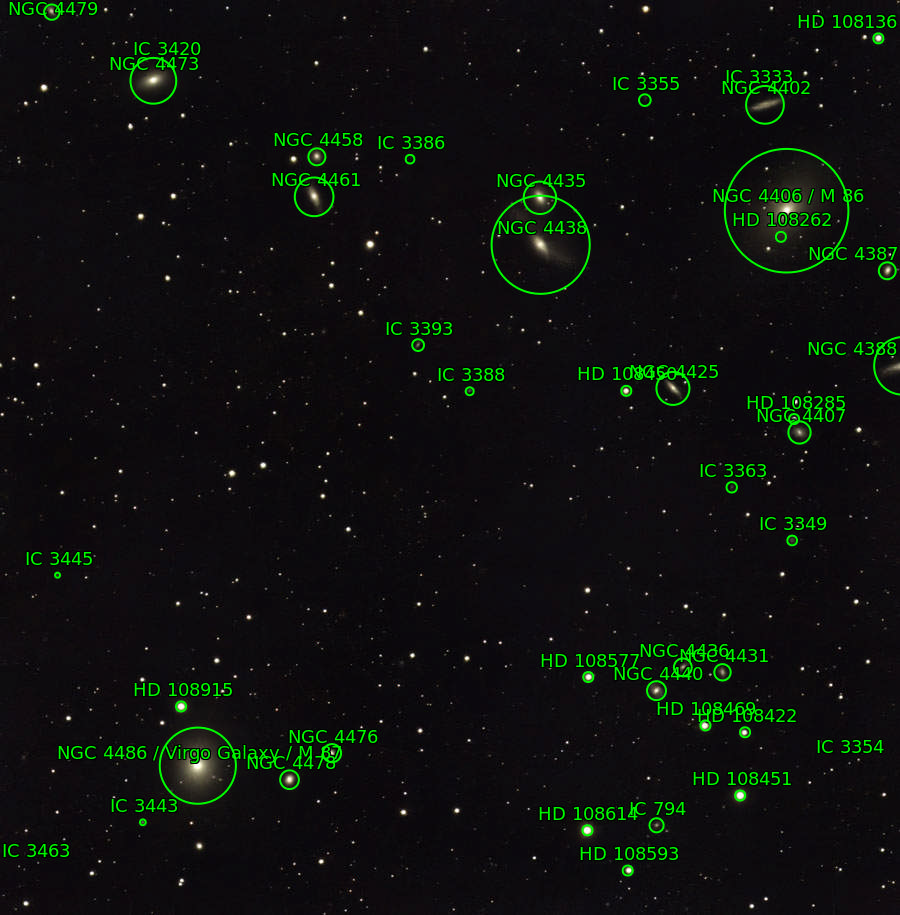 |
|
M 87, Apr 20, 2025 - 2000p, 17 min, processed and denoised (PAI) |
Evaluation with nova.astrometry.net* |
|
*) Galaxies nearby M 87: IC 3443, IC 3445, IC 3463, NGC 4476, NGC 4478
Galaxies west of M 87: IC 794, IC 3354, NGC 4431, NGC 4436, NGC 4440
Galaxies in Markarian's chain (upper half): IC 3333, IC 3349, IC 3355, IC 3363, IC 3388, IC 3393, IC 3420, NGC 4385, NGC 4387, NGC 4388, NGC 4402, NGC 4407, NGC 4425, NGC 4435, NGC 4438, NGC 4458, NGC 4461, NGC 4473, NGC 4479
It was not until early 2021 that I was informed by a star friend that there is a huge black hole at the center of M 87, whose activity makes M 87 one of the brightest radio and X-ray sources in the sky. A jet emanates from the galaxy's core, accelerating matter to nearly the speed of light. It can be observed visually only with large telescopes. It is, however, possible to photograph the jet - and I even managed to do so with the eVscope!
I took only two photos of M 87 on March 24, 2020. On both the jet can only be guessed with some good will. Here is one of the photos with the left arrow pointing to the jet:
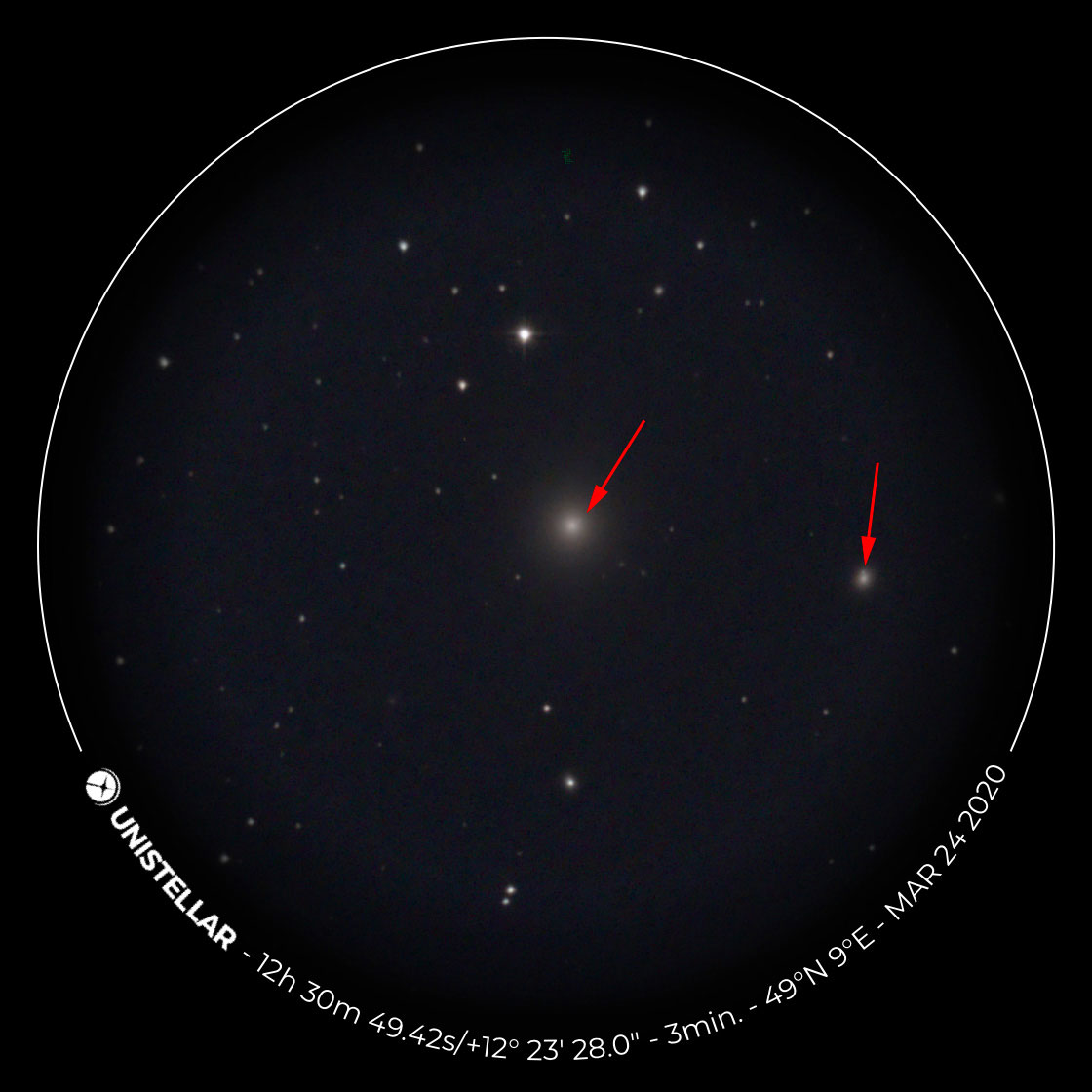
On the right (right arrow), there is the galaxy NGC 4478, which helped me for orientation purposes.
I then superimposed the two photos in Photoshop Elements and tested various layer calculations. Here are the best versions:
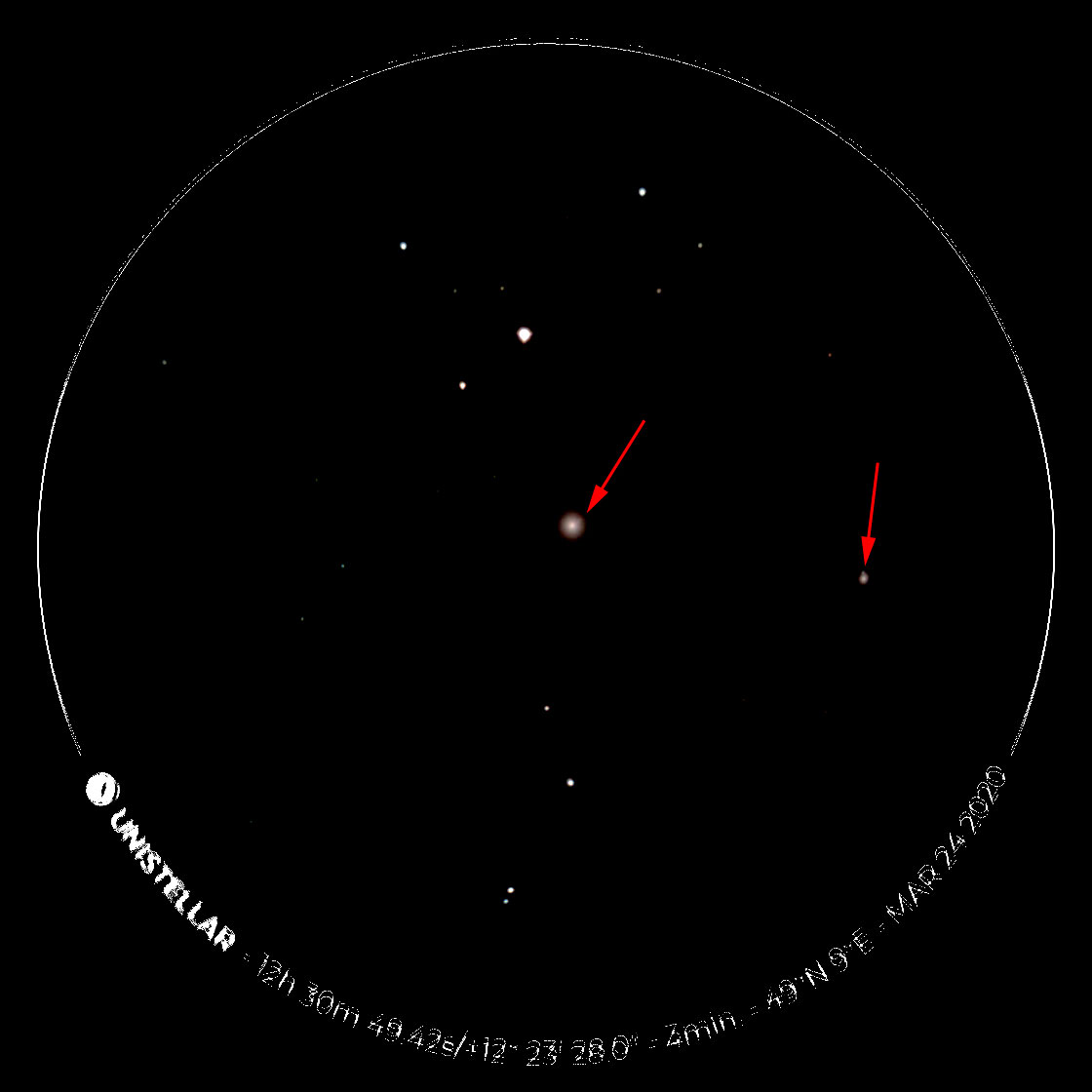
I superimposed the two photos so that the stars were aligned perfectly. Then, however, the overlays did no longer fit...
Here a second variant made from the two photos, however, without the arrows:
